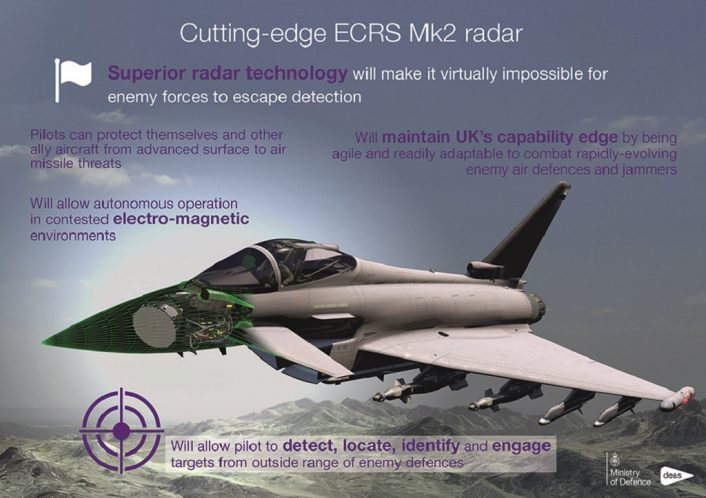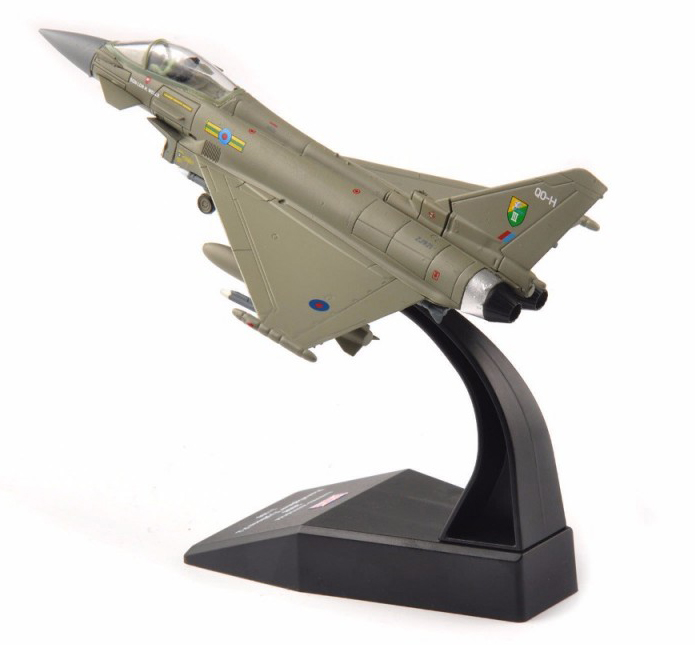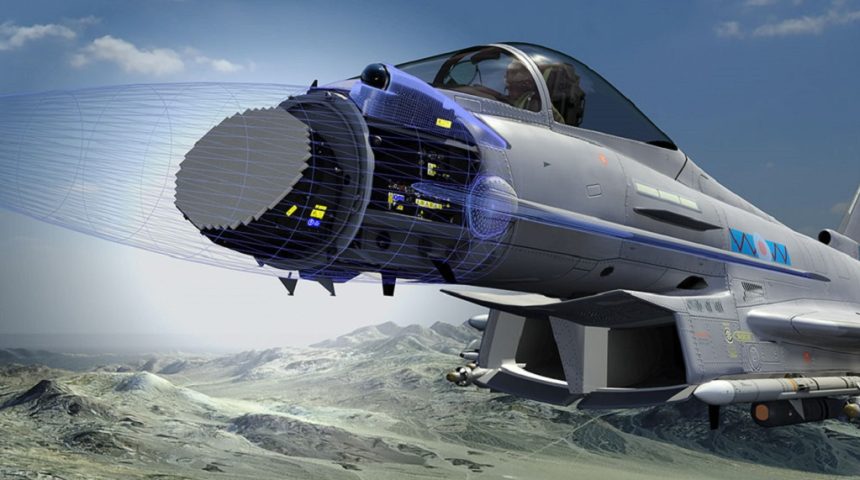The new radar, called European Common Radar System Mark 2, will enter service in the mid-2020s.
The Royal Air Force signed a £ 317 million (about USD 421 million) contract with Leonardo and BAE Systems to continue the development of the Active Electronically Scanned Array (AESA) European Common Radar System Mark 2 (ECRS Mk 2) for the Eurofighter Typhoon FGR4. The first AESA-equipped Typhoons will be delivered in 2022 for test and evaluation, while Initial Operating Capability (IOC) is planned to begin from 2025.
According to the UK MoD’s Defence Equipment & Support, “this maintains a highly-specialized, world-leading industry base that will ensure the UK remains at the forefront of radar technology development, which is essential for the Future Combat Air System (FCAS).”
World-leading radar will mean RAF Typhoon pilots can protect themselves and other aircraft from advanced surface to air missile threats and detect, locate, identify & engage targets from outside range of enemy defences.https://t.co/OR4ermab1q#Defence @DefenceHQ @RoyalAirForce pic.twitter.com/uQPSOhO9Lc
— Defence Equipment & Support (@DefenceES) September 3, 2020
This new radar is a special version of the Captor E AESA radar, or ECRS Mk 1, that is set to equip the Typhoons from Germany, Spain, and of the ECRS Mk 0 that will equip the aircraft of Kuwait and Qatar. The ECRS Mk 2 will also have an electronic warfare and electronic attack capacity that should be able to locate, identify and suppress enemy air defences using high-powered, wide-band jamming, while also being able to operate in contested electro-magnetic environments.
According to Leonardo’s press release, the new ECRS Mk2 radar features a revolutionary Multi-Function Array (MFA) and more Transmit-Receive Elements than any other AESA radar, “making Mk 2 the most capable fighter AESA radar in the world, maintaining the same power and precision of traditional radars but also enabling the simultaneous operation of its wide-band Electronic Warfare functionality”.
The company also said that they are tasked by the contract to develop the radar, while BAE is tasked with the integration of the sensor on the Typhoon, as the UK’s prime contractor for the aircraft. It is not known whether the Typhoon will retain the FGR4 designation or if they will assume a new one after the upgrade.

Apart from the detail in the press releases, we don’t know much about the characteristics of the Mk 2 radar. The only other info we got are from Leonardo’s and Eurofighter’s websites and are referred generally to the Captor E radar, without further info about the radar’s versions.
According to the websites, the Captor E AESA radar is based on a repositionable array that can be swiveled to cover up to 90° of azimuth, or even more at close range. The radar will feature improved range, detection and tracking over its mechanical predecessor, with the capability to operate simultaneously in both air-to-air and air-to-ground modes.
While the Mk 1 and Mk 2 variants are being developed, the Mk 0 radar is currently being tested aboard three Typhoons, IPA 5 (Instrumented Production Aircraft) in the UK, IPA 8 in Germany and, more recently, ISPA 6 (Instrumented Series Production Aircraft) in Italy. ISPA 6 is the aircraft used to develop and test the configuration for Kuwait which includes, other than the AESA radar, the P3Eb (Phase 3 Enhancements Package b) upgrades, the latest multi-role configuration, and the Lockheed Martin Sniper Advanced Targeting Pod. The latter was tested for the first time also on Typhoon ISPA 4, in Italy, recently.
.@eurofighter #Typhoon #ISPA4 equipped with the new @LockheedMartin Sniper Advanced Targeting pod puts the nose up and leaves #Turin with the “The Stone King” behind.
📸By Alessandro Maggia@BAESystemsAir #Eurofighter #Monviso #Alps pic.twitter.com/pab0IsUYTn
— Leonardo Aircraft (@LDO_Aircraft) August 26, 2020
It is not clear yet how many radars will be bought by the UK. According to an article by Jamie Hunter for The War Zone, there are plans to retrofit only a small fleet of Typhoons FGR4 of Tranche 3 with the new radar, which Janes quantifies in 40 aircraft, with a possible extension to the older Tranche 2 aircraft. A recent article from Defense Aerospace mentions also an Italian participation in the Mk 2 development, but this could be simply a reference to the fact that Leonardo is based both in Italy and UK since, there are no plans to upgrade the Italian Typhoons with the new radar; at least, not yet.
As for the other two variants, Germany and Spain ordered 110 and 5 Mk 1 radars respectively in July (again only a small part of the Typhoon fleet), while Kuwait and Qatar will get the Mk 0 radar on all their aircraft, 28 and 24 respectively. Nothing is known about a radar upgrade for the Typhoons operated by Saudi Arabia or Austria.










